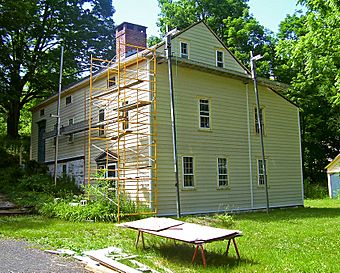Abraham Dickerson Farmhouse facts for kids
Quick facts for kids |
|
|
Abraham Dickerson Farmhouse
|
|

The house undergoing some renovation in 2007
|
|
| Location | Town of Montgomery, NY |
|---|---|
| Nearest city | Newburgh |
| Built | late 18th century |
| Architectural style | Federal style, Greek Revival |
| NRHP reference No. | 95001286 |
| Added to NRHP | November 3, 1995 |
The Abraham Dickerson Farmhouse is a historic house in the town of Montgomery, Orange County, New York, United States. It's a special old home that has been around for a long time. You can find it on West Searsville Road. This road was actually the original driveway to the house!
Contents
Discovering the Abraham Dickerson Farmhouse
The Abraham Dickerson Farmhouse is a really old house. It shows us what homes looked like many years ago. It's important because it tells a story about the people who lived there.
Who Was Abraham Dickerson?
Abraham Dickerson moved to the Hudson Valley area in the 1760s. He came from Long Island. He married a woman named Anna Mould. Her family was well-known in the area.
Dickerson bought land and built this house. He also built a sawmill nearby. The sawmill was on a stream called the Dwaar Kill. This stream flows into the Wallkill River.
Changes Over Time
The sawmill stopped working around the year 1800. Later, in 1829, another important local family bought the house. They were called the Van Alsts.
When the Van Alsts owned the house, they made some changes. They updated the house to the Greek Revival style. This was a very popular style of building back then. It often included tall columns and grand entrances.
The Famous Dancing Parlor
One interesting part of the house is the back section. It was designed to be a special room for dancing! Both the Dickerson and Van Alst families held many parties there. These parties often happened on Saturday nights.
Even in the 1920s, the house was still used for dances. At that time, it was a boardinghouse. This means people could rent rooms to live there. The dances were so popular that tenants had to make sure the dancing room was free every week.
Saving a Piece of History
After the 1920s, the house was not used much. It became empty and was left alone for a while. But in the late 1970s, people decided to fix it up. They worked hard to bring it back to life.
Because of its history and unique style, the house was added to the National Register of Historic Places in 1995. This means it's recognized as an important historical building.
Images for kids


